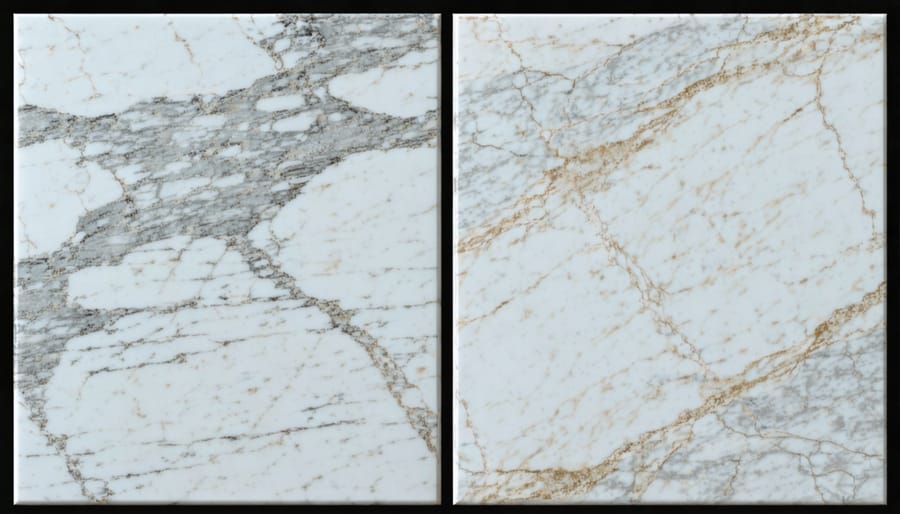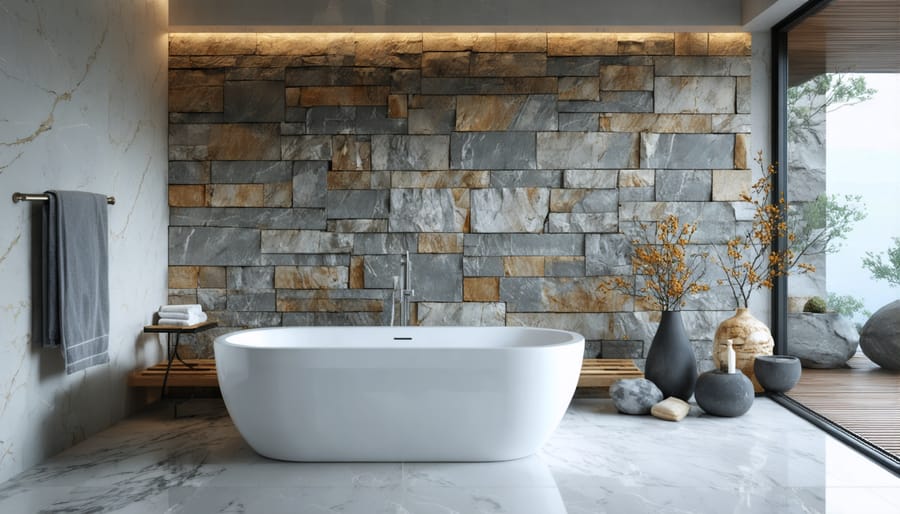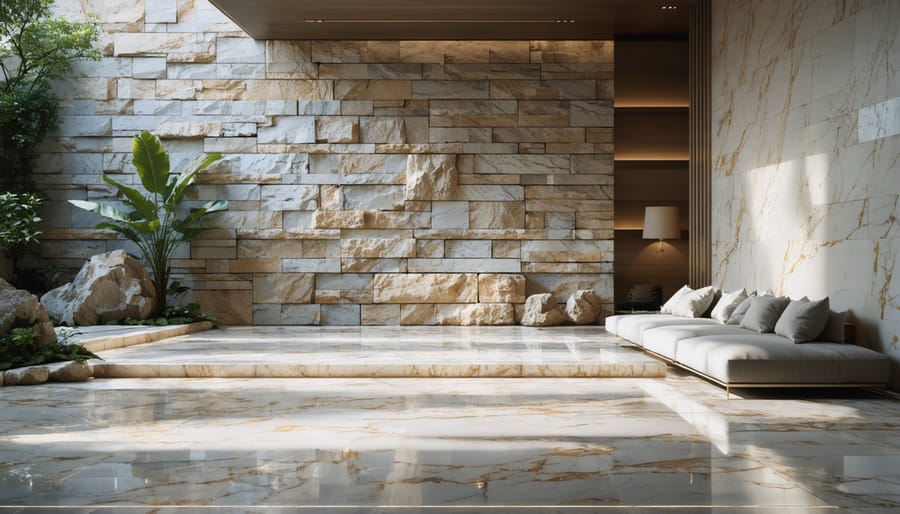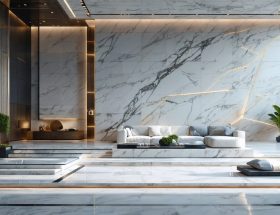Textural contrast in stone transforms ordinary surfaces into compelling design statements, creating visual drama through the deliberate interplay of smooth and rough finishes. When polished marble meets rough-hewn granite, or honed limestone pairs with split-face travertine, these opposing textures create depth and dimension that elevate architectural spaces beyond mere functionality. The strategic combination of contrasting stone surfaces – from glossy to matte, bush-hammered to flame-finished – establishes focal points and defines spatial hierarchies while engaging both visual and tactile senses. In contemporary design, this interplay of textures has evolved from a subtle architectural detail to a foundational element of modern aesthetics, allowing designers to craft sophisticated environments that celebrate the natural diversity of stone materials. Through thoughtful application of textural contrast, spaces acquire layers of visual interest that respond dynamically to changing light conditions and viewing angles, creating environments that are both visually striking and emotionally resonant.
The Power of Textural Contrasts in Stone Design
Visual Impact of Mixed Textures
The interplay of mixed stone textures creates powerful visual dynamics that can transform any space. When combining rough-hewn surfaces with polished finishes, the contrast immediately draws the eye and adds depth to architectural elements. Following modern stone design principles, designers often pair smooth marble with textured limestone or bush-hammered granite to create engaging focal points.
These textural variations affect how light interacts with the stone surfaces, creating subtle shadows and highlights that change throughout the day. A polished granite countertop adjacent to a split-face stone wall, for instance, creates a dramatic interplay between sleek sophistication and natural ruggedness. The contrast can make spaces feel more dynamic and intentionally designed, while also helping to define distinct zones within open floor plans.
When thoughtfully executed, mixed textures can enhance the perceived value of a space while creating an atmosphere that balances refinement with organic warmth.
Design Psychology Behind Textural Contrast
Textural contrast in design works on both conscious and subconscious levels, significantly impacting how we perceive and experience spaces. When smooth and rough surfaces are strategically combined, they create visual tension that draws the eye and engages our tactile senses. This interplay affects spatial perception by creating depth and dimension, making rooms feel more dynamic and intentionally designed.
Research shows that textural contrasts can influence mood and emotional responses. Smooth surfaces often evoke feelings of calm and sophistication, while rougher textures add warmth and organic character to a space. The human brain naturally seeks patterns and variation, making textural contrast an essential tool for creating engaging environments.
In natural stone applications, this psychological principle translates to practical design choices. For instance, combining honed marble with split-face limestone can define distinct zones within a space while maintaining visual harmony. The contrast between polished and bush-hammered finishes creates focal points that guide movement and attention throughout the room, contributing to a well-balanced and psychologically satisfying environment.
Popular Stone Pattern Combinations
Polished and Honed Combinations
The combination of polished and honed finishes creates a sophisticated interplay of textures that can transform any stone installation from ordinary to extraordinary. This pairing works exceptionally well in large-format applications, where the contrast becomes a deliberate design statement rather than a subtle detail.
In contemporary kitchen designs, mixing polished countertops with honed backsplashes has become increasingly popular. The reflective surface of a polished granite island can create a stunning focal point while a honed limestone backsplash provides a softer, more muted complement. This combination not only adds visual interest but also serves practical purposes – polished surfaces are easier to clean, while honed finishes help conceal fingerprints and water spots.
Bathroom applications benefit similarly from this dual-finish approach. Consider a vanity top featuring polished marble bordered by honed stone chair rails, or shower walls that alternate between both finishes to create subtle pattern variations. The contrast becomes particularly striking when working with darker stones like absolute black granite or rich emperador marble.
Commercial spaces often utilize this combination to define different functional areas. Polished flooring in high-traffic zones maintains its appearance longer, while honed finishes in seating areas provide better traction and a more relaxed atmosphere. The transition between these finishes can serve as an elegant wayfinding element without the need for additional signage.

Rough and Smooth Stone Pairings
The interplay between rough and smooth stone textures creates compelling visual and tactile experiences in architectural design. One of the most successful pairings combines split-faced granite with polished marble, where the rugged, natural charm of the granite provides a striking backdrop for marble’s sleek elegance. This combination is particularly effective in creating biophilic design elements that connect indoor spaces with nature.
Rough limestone paired with honed travertine offers another harmonious contrast, especially in Mediterranean-inspired spaces. The weathered surface of the limestone adds depth and character, while the smooth travertine brings sophistication and refinement. This pairing works exceptionally well in entryways and outdoor living spaces.
For contemporary designs, rough-hewn slate combined with polished basalt creates a dramatic effect. The slate’s natural cleft surface provides rich texture and dimension, while the basalt’s mirror-like finish adds modern sophistication. This combination is particularly striking in feature walls and fireplace surrounds.
In bathroom applications, bush-hammered granite paired with polished quartzite delivers both visual interest and practical functionality. The textured granite provides slip resistance in wet areas, while the smooth quartzite surfaces offer easy maintenance and luxurious appeal. Consider using these contrasting finishes strategically to define different zones within the same space.

Application Techniques and Best Practices
Pattern Layout Strategies
When arranging different stone patterns, strategic placement is crucial for achieving optimal visual impact. Start by establishing a dominant texture that will serve as your primary design element, then layer contrasting patterns to create depth and interest. Consider the rule of thirds when planning your layout, dividing the space into sections that balance different textures without overwhelming the eye.
Large-format smooth stones work well as a foundation, while incorporating smaller, more textured elements can create focal points and visual movement. For instance, combining polished marble with split-face limestone can create dramatic transitions between spaces. Reclaimed stone textures can add character and historical depth when integrated thoughtfully into modern designs.
Pay attention to scale when mixing patterns – larger spaces can handle bold contrasts, while smaller areas benefit from subtle textural variations. Create transition zones between different textures using borders or accent strips to ensure smooth visual flow. Consider the natural light in your space, as it significantly affects how textures are perceived throughout the day.
For exterior applications, arrange patterns to complement architectural features while ensuring practical considerations like water drainage. In interior spaces, use textural contrast to define functional areas or create subtle wayfinding cues through pattern transitions.

Installation Considerations
When installing patterns with textural contrast, proper planning and execution are crucial for achieving the desired visual impact while ensuring structural integrity. Begin by carefully evaluating the substrate to confirm it can support mixed stone types, particularly when combining materials of different weights and thicknesses.
Installation should follow a precise layout plan, marking reference lines and dry-laying the pattern before permanent placement. This step helps verify the overall design and allows adjustments to achieve optimal contrast distribution. Pay special attention to transition areas between different textures, ensuring proper spacing and alignment.
For mixed-texture installations, use setting materials appropriate for each stone type. Different stones may require varying mortars or adhesives based on their porosity and surface characteristics. Maintain consistent joint widths throughout the installation, using spacers when necessary to preserve the design’s uniformity.
Consider the final surface plane when working with stones of varying thicknesses. Lippage control systems can help achieve a level surface while maintaining the intended textural variations. For exterior applications, ensure proper drainage provisions and use weather-resistant setting materials.
Sealing requirements may vary between different stone textures. Some rough-textured stones might need multiple sealer applications, while smooth surfaces may require less. Always test sealer compatibility on each texture type before full application.
Design Tips for Balanced Contrast
Creating balanced textural contrast in stone applications requires careful consideration of scale, placement, and proportion. Start by selecting stone finishes that complement rather than compete with each other. For instance, pair a heavily textured split-face stone with a smooth honed surface to create visual interest without overwhelming the space.
The rule of 60/30/10 works well for textural contrast: use your dominant texture for 60% of the surface area, a secondary texture for 30%, and an accent texture for the remaining 10%. This distribution helps maintain visual harmony while preventing any single texture from dominating the design.
Consider the viewing distance when selecting textures. Subtle variations work better in close-up applications, while bolder contrasts are more effective when viewed from a distance. Natural light also plays a crucial role – strongly textured surfaces create more dramatic shadows, which can either enhance or overwhelm a space depending on the lighting conditions.
When mixing textures, maintain consistency in color palette to ensure the contrasts remain sophisticated rather than chaotic. For vertical applications, place heavier textures at the bottom to create a sense of grounding, gradually transitioning to smoother finishes as you move upward.
Remember to factor in practical considerations alongside aesthetics. High-traffic areas may benefit from smoother textures for easier maintenance, while feature walls can showcase more dramatic textural variations.
Textural contrast in natural stone applications offers endless possibilities for creating visually striking and emotionally resonant spaces. By thoughtfully combining smooth and rough surfaces, polished and honed finishes, or varying stone patterns, designers can achieve unique aesthetic effects that enhance any environment. Remember to consider the practical aspects of maintenance and durability when selecting contrasting textures, and always account for the space’s intended use and lighting conditions. Whether you’re planning a residential renovation or commercial project, start with small accent pieces to experiment with textural combinations before committing to larger installations. The key to successful textural contrast lies in finding the right balance between bold statement features and subtle complementary elements, ensuring your design remains timeless while making a lasting impression.










